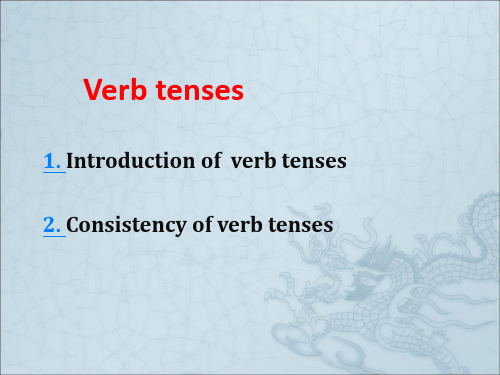Verb Tenses
- 格式:ppt
- 大小:1.94 MB
- 文档页数:18



八上英语第五单元语法英语八上第五单元语法The fifth unit of Grade 8 English focuses on grammar. In this unit, students will learn about different grammatical structures and how to use them correctly in sentences. The unit covers topics such as verb tenses, passive voice, reported speech, and conditional sentences. Through various exercises and activities, students will practice applying these grammar rules and enhance their overall language proficiency.1. Verb TensesVerb tenses play a crucial role in conveying the timeline and duration of events. Understanding the correct usage of each tense is essential for effective communication. This unit introduces the three main verb tenses: present, past, and future. Within each tense, there are further subcategories such as simple, continuous, perfect, and perfect continuous. Students will learn how to form and use these tenses in both affirmative and negative sentences, as well as in questions.2. Passive VoiceThe passive voice is another important grammatical structure that students will study in this unit. It is used to emphasize the action and the recipient of the action, rather than the doer. By learning how to convert active sentences into passive ones, students will acquire a valuable tool for clear and concise writing. Through practice exercises, they will become more familiar with the passive voice and recognize when to use it appropriately.3. Reported SpeechReported speech, also known as indirect speech, is used to relay what someone else said without quoting them directly. This unit guides students through the process of transforming direct speech into reported speech, including changes in tenses, pronouns, and time expressions. By mastering this skill, students will be able to accurately convey information from a secondhand source and enhance their listening and reading comprehension abilities.4. Conditional SentencesConditional sentences express hypothetical situations and their probable outcomes. In this unit, students will learn about the four main types of conditional sentences: zero, first, second, and third conditionals. Each type has a specific structure and usage. Through practice exercises, students will gain a better understanding of these structures and develop their ability to express hypothetical situations in English.In conclusion, the fifth unit of Grade 8 English focuses on grammar and equips students with essential language skills. By studying verb tenses, passive voice, reported speech, and conditional sentences, students will enhance their overall language proficiency and strengthen their ability to communicate effectively. This unit provides an opportunity to practice these grammar rules in a structured and engaging manner, allowing students to build a solid foundation for their English language development. With continued practice and exposure to authentic English materials, students will be well-equipped to achieve fluency in the language.。

最难英语知识点总结1. Verb tensesOne of the most challenging aspects of English grammar is understanding and using verb tenses correctly. English has 12 tenses, including simple present, present continuous, present perfect, present perfect continuous, simple past, past continuous, past perfect, past perfect continuous, simple future, future continuous, future perfect, and future perfect continuous. Each tense has its own rules and usage, making it difficult for learners to grasp. To master verb tenses, it is essential to practice using them in context. Reading and listening to English materials can help learners internalize the correct usage of each tense. Additionally, regular practice and exercises can help solidify the understanding of verb tenses.2. ArticlesThe use of articles (a, an, the) in English can be confusing for non-native speakers. Knowing when to use "a" or "an" and when to use "the" (or when not to use an article at all) requires a good understanding of context and specificity. This can be particularly challenging for speakers of languages that do not have articles.To overcome this difficulty, learners should pay close attention to the use of articles in authentic English materials. Reading extensively and noticing how articles are used in different contexts can help learners develop a natural feel for when to use them. Additionally, practicing with exercises and seeking feedback from native speakers can help improve article usage.3. Phrasal verbsPhrasal verbs are combinations of a verb and one or more particles (such as a preposition or an adverb) that together have a different meaning from the original verb. For example, "give up" means to quit or surrender, while "look after" means to take care of someone or something. The vast number of phrasal verbs and their varied meanings can make them challenging for learners to master.To tackle phrasal verbs, learners should approach them in context and learn them in their natural usage. Reading and listening to English materials can expose learners to a wide range of phrasal verbs and help them understand their meanings. It is also helpful to create flashcards or lists of phrasal verbs and their meanings for review and practice.4. PronunciationEnglish pronunciation can be difficult due to its lack of regularity and the multitude of silent letters, stress patterns, and variations in vowel and consonant sounds. Additionally, English has a wide range of accents and dialects, making it challenging for learners to understand and imitate native speakers' pronunciation.To improve pronunciation, learners should listen to and mimic native speakers as much as possible. Watching English language media, such as movies, TV shows, and videos, can help learners pick up on natural pronunciation and intonation. It is also helpful to practice speaking with native speakers and seek feedback on pronunciation and intonation.5. Idioms and figurative languageEnglish is rich in idiomatic expressions and figurative language, which can be puzzling for non-native speakers. Idioms are phrases that have figurative meanings that differ from their literal interpretations, such as "break a leg" or "raining cats and dogs." Understanding and using idioms correctly can be challenging for learners.To master idiomatic expressions, learners should familiarize themselves with common idioms through reading and listening to English materials. It is helpful to learn the meanings and usage of idioms in context and practice incorporating them into everyday speech. Additionally, seeking explanations and examples of idioms from native speakers can provide valuable insight.In conclusion, the English language presents numerous challenges for learners, from intricate grammar rules to diverse pronunciation and idiomatic expressions. However, with dedication, practice, and exposure to authentic English materials, learners can overcome these difficulties and master the complexities of the language. By understanding the nuances of verb tenses, articles, phrasal verbs, pronunciation, and idioms, learners can enhance their English language proficiency and communicate with confidence.。


英语必背5个知识点总结1. Subject-Verb Agreement:The subject of a sentence and its verb must agree in number and person. For example, "The cat (singular subject) is (singular verb) sleeping on the bed." However, if the subject is plural, as in, "The cats (plural subject) are (plural verb) playing in the garden."2. Articles:There are three articles in English: a, an, and the. "A" and "an" are indefinite articles used to refer to non-specific nouns, while "the" is a definite article used to refer to specific nouns. For example, "I have a cat (non-specific noun)," and "The cat (specific noun) is black."3. Verb Tenses:English has several verb tenses, including past, present, and future. It's important to understand how to use these tenses correctly to convey the timing of an action. For example, "I ate (past tense) breakfast this morning," "I am eating (present tense) lunch right now," and "I will eat (future tense) dinner tonight."4. Adjectives and Adverbs:Adjectives are used to describe nouns, while adverbs are used to describe verbs, adjectives, or other adverbs. It's essential to understand the difference and use them appropriately in sentences. For example, "She has a beautiful (adjective) flower," and "She sings beautifully (adverb)."5. Prepositions:Prepositions are words that show the relationship between a noun or pronoun and other words in a sentence. Some common prepositions include in, on, at, to, and for. For example, "The book is on the table," and "I am going to the store."These five grammar points are essential for anyone learning English, as they form the foundation of the language and are used in every aspect of communication. Mastering these points will help learners to speak and write English fluently and accurately.。
谓语动词的时态(一)Verb Tense(1)谓语动词的时态(一)Verb Tense(1)1.一般现在时(The Simple present Tense)一般现在时表示主语的状态、特征,经常或反复发生的动作,或表示真理。
1.一般现在时(The Simple present Tense)如:He is fourteen. He is at school.Do you go to school at 7 every day?She doesn't like apples.The earth moves around the sun.1.一般现在时(The Simple present Tense)谓语动词用原形,当主语为第三人称单数时,动词原形的词尾有加-s的变化。
变化如表:注意:•动词be 的一般现在时是am,is,are;•动词have 的第三人称单数形式是has。
谓语动词的时态(一)Verb Tense(1)2.一般过去时(The Simple Past Tense)一般过去时表示过去某个时间发生的动作或存在的状态,常和表示过去的时间状语连用,如:yesterday,last night, in 1989, two days ago等。
Tense)如:My teacher wasn't at home last Saturday.He was in the library.He got up at 6 this morning.She didn't watch TV.She did some reading.Tense)一般过去时要用动词的过去式,规则动词的词尾加-ed,不规则的要记。
规则动词过去式的构成:2.一般过去时(The Simple Past Tense常见的不规则动词的过去式变化,如:am / is—was are—were go—went have—had do—did get—got come—came say—said see—saw put—put eat—ate take—took谓语动词的时态(一)Verb Tense(1)3.一般将来时(The Simple Future Tense)一般将来时表示将来某个时间要发生的动作或存在的状态,常与表示将来的时间状语连用,如:tomorrow, next week, next Sunday等。